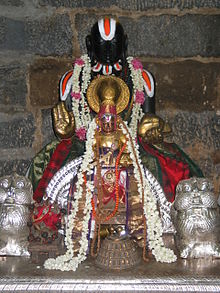

Thirunakshatram of Tondaradipodi azhwar on Decembe.Thirunakshatram of Swami Periya Nambi on December.
 Thirunakshatram of Swami Naalooranachan Pillai /rebates/&252fthiruvaimozhi-in-tamil-wikipedia. 1 Gita Sloka Every Day - Chapter 15 - Purushottam. ESSENCE OF THE FIFTEENTH CHAPTER-16TH PAASURAM. Verse 12 to 14 state that the sun, moon, fire and the earth and the fire that digests the food of animals are all his vibhutis The next verse states that the bound atma is also his vibhuti and explains why some are bound are some are free. Verse 6 points out the nature of the freed atma, that he is self proved and adds that he is the vibhuti of the highest atma. Verse 4 points out that by doing prapatti it is possible to secure the grace of the highest atma and to destroy the attachment to the fruits of the gunas and its root, misconception. The means to end this bondage is non-attachment. The Tiruvaymoli is a 1102-verse Tamil poem, composed in the ninth century by the Hindu poet-saint Nammalvar, who is regarded as the foremost of the Alvar. They are therefore the lower and upper branches of the tree of bondage respectively. Sacred Verses of the Woman) 1 is a set of 143 verses composed by Andal, one of the twelve Alvars in Vaishnava tradition. It has roots below in the world of men in the form of karmas for by karmas done by atmas as men, they again become men, brutes and the like below they become devas above. This unique tree is nourished by vedic texts pointing out the means to various fruits, as a tree is nourished by its leaves. Its branches are below, as it ends with all men, brutes, worms, insects, and vegetables etcc that live on the earth.
Thirunakshatram of Swami Naalooranachan Pillai /rebates/&252fthiruvaimozhi-in-tamil-wikipedia. 1 Gita Sloka Every Day - Chapter 15 - Purushottam. ESSENCE OF THE FIFTEENTH CHAPTER-16TH PAASURAM. Verse 12 to 14 state that the sun, moon, fire and the earth and the fire that digests the food of animals are all his vibhutis The next verse states that the bound atma is also his vibhuti and explains why some are bound are some are free. Verse 6 points out the nature of the freed atma, that he is self proved and adds that he is the vibhuti of the highest atma. Verse 4 points out that by doing prapatti it is possible to secure the grace of the highest atma and to destroy the attachment to the fruits of the gunas and its root, misconception. The means to end this bondage is non-attachment. The Tiruvaymoli is a 1102-verse Tamil poem, composed in the ninth century by the Hindu poet-saint Nammalvar, who is regarded as the foremost of the Alvar. They are therefore the lower and upper branches of the tree of bondage respectively. Sacred Verses of the Woman) 1 is a set of 143 verses composed by Andal, one of the twelve Alvars in Vaishnava tradition. It has roots below in the world of men in the form of karmas for by karmas done by atmas as men, they again become men, brutes and the like below they become devas above. This unique tree is nourished by vedic texts pointing out the means to various fruits, as a tree is nourished by its leaves. Its branches are below, as it ends with all men, brutes, worms, insects, and vegetables etcc that live on the earth. THIRUVAIMOZHI IN TAMIL WIKIPEDIA FREE
Puhar - Wikipedia, The Free Encyclopedia.

Its root is above, as it begins with the four faced being whose world is above the earth. ThiruvAimozhi (6), RaamAnusa NooRRanthAdhi (3) and Adaikkala Patthu (2). To enable one to grasp the nature of bondage, it is compared with the peepul tree. As subsidiary to the main topic of the chapters, verses 1 to 15, state that the bound atma, the freed atma and the non-intelligent products of the matter are the vibhutis of the highest Atma.







 0 kommentar(er)
0 kommentar(er)
